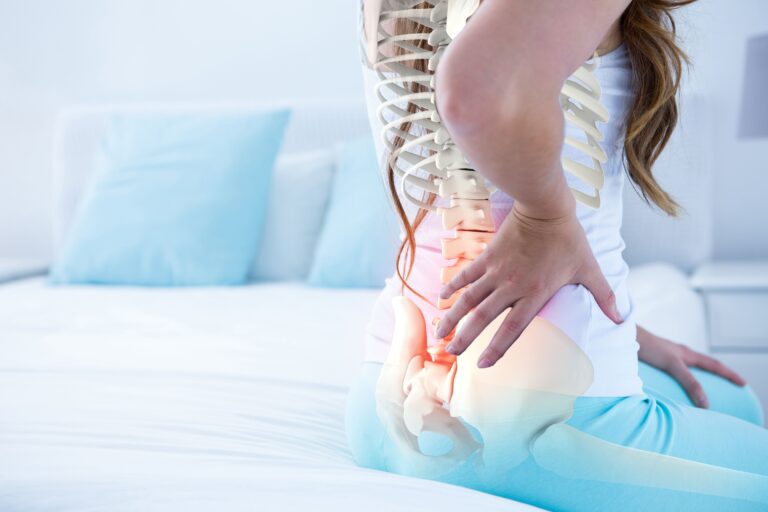Sleep quality in individuals with endometriosis is significantly worse than those without it (Nunes et al., 2015). It seems like a no-brainer that pain and other symptoms from endometriosis can affect sleep quality. In fact, pain from endometriosis is known to affect a person’s “work/school, daily activities, exercise, and sleep to a moderate-extreme degree” (DiVasta et al., 2018). And in a vicious cycle, pain affects sleep and poor sleep affects pain. We get how pain can affect sleep, but what are the mechanics behind poor sleep affecting pain?
Ishikura et al. (2020) explains:
“It is well known that any pain condition can affect sleep, leading to sleep disturbances and impairment in sleep quality. In turn, sleep disruption can activate inflammatory mechanisms by triggering changes in the effector systems that regulate the immune system, resulting in abnormal increases in inflammatory responses that can stimulate or increase pain. This can result in the creation of a vicious cycle, with pain causing sleep disturbance that increases inflammation, leading to increased pain. Moreover, experimental studies have shown that the association of sleep loss and inflammatory markers are stronger in females than males, suggesting that women with both insomnia and endometriosis complaints are more susceptible to symptoms of pain. Endometriosis induces several debilitating symptoms that affect women´s lives, including insomnia; however, there have been very few studies of this association…. Treating insomnia would reduce the negative outcomes related to the inflammatory- and pain-related aspects of endometriosis and would contribute to an improvement in mental health and daytime function.”
This poor sleep can increase fatigue, affect quality of life, increase stress, and be detrimental to mental health in those with endometriosis (Arion et al., 2020; Ramin-Wright et al., 2018). Hormonal fluctuations within the menstrual cycle can affect sleep quality as well (drop in progesterone before menses, rise in body temperature during the luteal phase). Some hormonal treatments can affect sleep (Brown et al., 2008).
What can we do to help our sleep? Step one is to have a plan to address the underlying factors affecting sleep such as removing endometriosis. In the meantime, practice pain reduction techniques (nutrition, complimentary therapies such as yoga, pelvic physical therapy, etc.), practice good sleep hygiene, and talk to your healthcare provider about ways to manage pain and insomnia. One study indicated that “melatonin improved sleep quality” and “reduced the risk of using an analgesic by 80%” in patients with endometriosis (Schwertner et al., 2013). The American Academy of Sleep Medicine (2020) reports that cognitive behavioral therapy is the most effective therapy for chronic insomnia. They also suggest:
Keep a consistent sleep schedule. Get up at the same time every day, even on weekends or during vacations.
Set a bedtime that is early enough for you to get at least 7-8 hours of sleep.
Don’t go to bed unless you are sleepy.
If you don’t fall asleep after 20 minutes, get out of bed. Go do a quiet activity without a lot of light exposure. It is especially important to not get on electronics.
Establish a relaxing bedtime routine.
Use your bed only for sleep and sex.
Make your bedroom quiet and relaxing. Keep the room at a comfortable, cool temperature.
Limit exposure to bright light in the evenings.
Turn off electronic devices at least 30 minutes before bedtime.
Don’t eat a large meal before bedtime. If you are hungry at night, eat a light, healthy snack.
Exercise regularly and maintain a healthy diet.
Avoid consuming caffeine in the afternoon or evening.
Avoid consuming alcohol before bedtime.
Reduce your fluid intake before bedtime.
American Academy of Sleep Medicine (2020)
References
American Academy of Sleep Medicine. (2020). Healthy sleep habits. Retrieved from https://sleepeducation.org/healthy-sleep/healthy-sleep-habits/
Arion, K., Orr, N. L., Noga, H., Allaire, C., Williams, C., Bedaiwy, M. A., & Yong, P. J. (2020). A quantitative analysis of sleep quality in women with endometriosis. Journal of Women’s Health, 29(9), 1209-1215. Retrieved from https://www.liebertpub.com/doi/abs/10.1089/jwh.2019.8008
Brown, S. G., Morrison, L. A., Larkspur, L. M., Marsh, A. L., & Nicolaisen, N. (2008). Well-being, sleep, exercise patterns, and the menstrual cycle: a comparison of natural hormones, oral contraceptives and depo-provera. Women & health, 47(1), 105-121. Retrieved from https://doi.org/10.1300/J013v47n01_06
DiVasta, A. D., Vitonis, A. F., Laufer, M. R., & Missmer, S. A. (2018). Spectrum of symptoms in women diagnosed with endometriosis during adolescence vs adulthood. American journal of obstetrics and gynecology, 218(3), 324-e1. Retrieved from https://doi.org/10.1016/j.ajog.2017.12.007
Ishikura, I. A., Hachul, H., Pires, G. N., Tufik, S., & Andersen, M. L. (2020). The relationship between insomnia and endometriosis. Journal of Clinical Sleep Medicine, 16(8), 1387-1388. Retrieved from https://doi.org/10.5664/jcsm.8464
Nunes, F. R., Ferreira, J. M., & Bahamondes, L. (2015). Pain threshold and sleep quality in women with endometriosis. European Journal of Pain, 19(1), 15-20. Retrieved from https://doi.org/10.1002/ejp.514
Ramin-Wright, A., Schwartz, A. S. K., Geraedts, K., Rauchfuss, M., Wölfler, M. M., Haeberlin, F., … & Leeners, B. (2018). Fatigue–a symptom in endometriosis. Human reproduction, 33(8), 1459-1465. Retrieved from https://doi.org/10.1093/humrep/dey115
Schwertner, A., Dos Santos, C. C. C., Costa, G. D., Deitos, A., de Souza, A., de Souza, I. C. C., … & Caumo, W. (2013). Efficacy of melatonin in the treatment of endometriosis: a phase II, randomized, double-blind, placebo-controlled trial. PAIN®, 154(6), 874-881. Retrieved from https://www.sciencedirect.com/science/article/abs/pii/S030439591300081X

